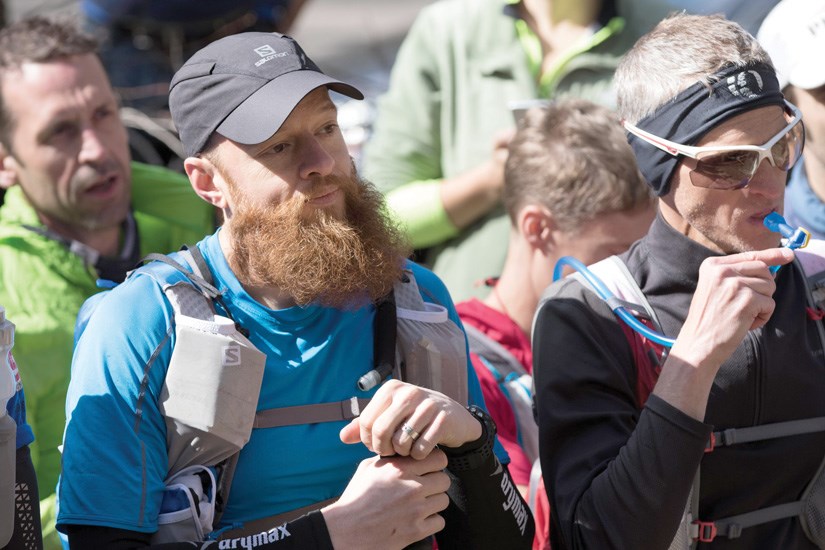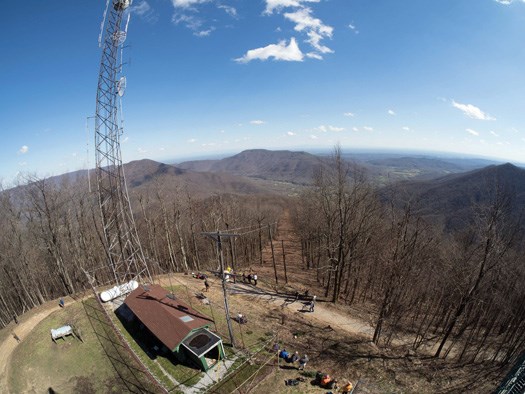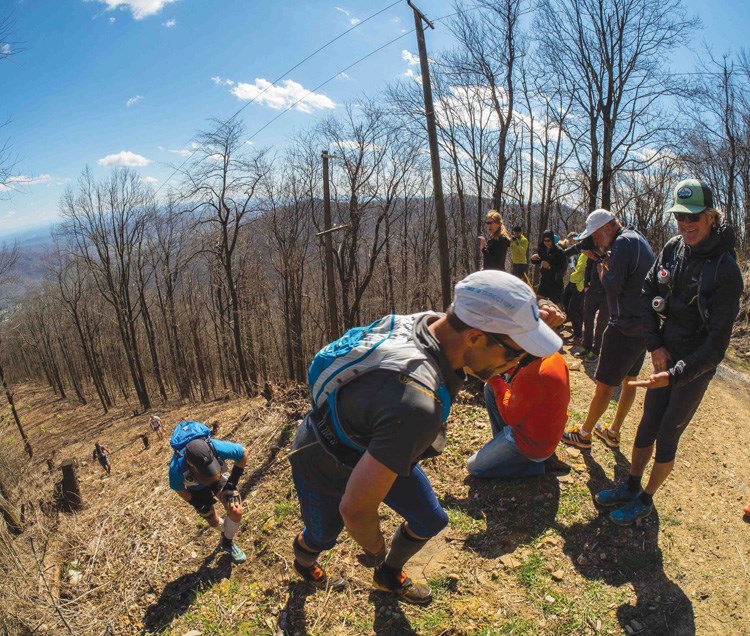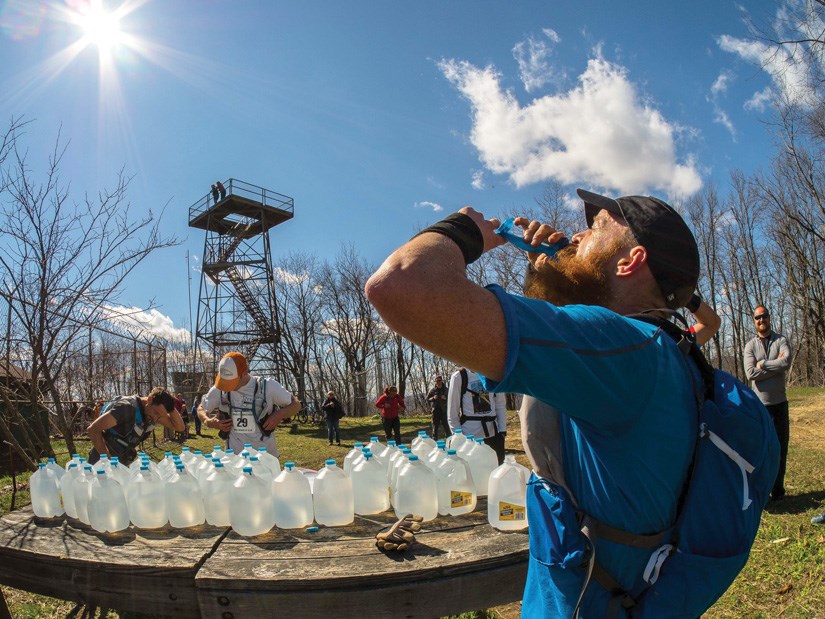Last weekend North Vancouver’s Gary Robbins ran through leg-shredding terrain for nearly 60 hours straight, overcoming incredible mental and physical barriers to accomplish a feat only a handful of humans on this earth could achieve.
And yet, in the eyes of the The Barkley Marathons, he failed.
“I think anybody going into The Barkley knows that you are destined to fail,” said Robbins, a highly decorated ultra-runner who currently holds the records for several of the world’s toughest foot races, including the 100-mile Hurt 100 in Hawaii and 93-mile Wonderland Trail FKT, which circumnavigates Mount Rainier in Washington State. “I’m good at failing because I can step back from failures and kind of assess what went right and what went wrong and take those lessons and move forward and come back with a better strategy for the future.”
The strategy for most people who take part in the highly mysterious and insanely difficult Barkley Marathons is to survive one loop of the five-loop, 100-plus mile race. Robbins, running it for the first time, survived 4.5 loops. It’s the farthest any Canadian has ever made it in the race, and the third farthest for any race rookie. In doing so he learned a lot about himself, about the human spirit, about life itself. Most of all, however, he learned that he will be haunted by that unfinished half lap until he can come back to the backwaters of Eastern Tennessee and vanquish the demons that chased him away.
The mysterious Barkley Marathons
The town of Wartburg was the last bit of civilization Robbins, his wife Linda Barton-Robbins and their seven-month-old son Reed saw before heading into Tennessee’s Frozen Head State Park, the race zone for The Barkley Marathons.
“It was underwhelming in every regard,” Robbins said with a laugh when the North Shore News caught up with him following the race. “It’s a tiny little Southern U.S. town. It’s very much about guns and freedom – there’s no disguising that they’re very passionate about that down there. But Southern hospitality is an absolute thing – they’re some of the nicest people we had ever met.”
Once they were inside the State Park, they sought out Gary Cantrell, a.k.a. Lazarus Lake, the man whose mischievous mind created The Barkley Marathons. It was Lake who sent Robbins a “letter of condolence” informing him that he was one of the 40 elite racers selected to run in this year’s Barkley. The race has a bit of Fight Club mystique to it, particularly pertaining to the application process used to select the runners. If you talk about the race too much, you may never get invited back.
“There are certain things that I will not reveal,” said Robbins. When he first met Lake, however, Robbins happily passed him a licence plate from his place of birth, Newfoundland – a licence plate is the entry fee for first-time racers – and then handed over his baby as well, warning Lake that Reed is a beard puller.
“As long as he grabs the whole thing it’s fine,” said Lake, whose thick, scraggly white beard matched well with the massive red one Robbins was sporting.
“He was everything I had hoped and expected – you can see the kind generosity behind his eyes,” Robbins said of Lake. “You could also see that he’s a mischievous soul. He very much likes to stir the pot, and I think that shines through in what he’s created here.”
What Lake created was a race both wacky and agonizing. The Barkley gained mainstream fame recently following the release of The Barkley Marathons: The Race That Eats Its Young, a documentary film, co-produced by Annika Iltis and Timothy Kane, that has become a Netflix favourite. The Barkley, however, was first contested in 1986 and has built up a huge reputation in the ultra-running world since then.
Each year, 40 hand-picked participants attempt to tackle five loops of a course that is at least 20 miles (32 kilometres) long, although runners swear it is closer to the 26 miles of an actual marathon. The course rises and falls through the rounded Tennessee mountains, racking up cumulative elevation gains and drops that are – according to the documentary – roughly equivalent to climbing and descending Mount Everest. Twice.
In the 30 years since the race was created, 14 humans have finished all five loops in the allotted 60 hours.

The event is known for its numerous quirks. The race can begin anytime from 11 p.m. to 11 a.m. on race day, with Lake blowing a conch to let racers know the race will begin in one hour. The start is then signalled by Lake lighting a cigarette.
The course is not marked – one map is provided to all the runners the night before the race. There are few aid stations along the course and racers mark their progress by finding books along the way and tearing out pages corresponding to their bib number.
Robbins pondered all of these variables as he waited inside his tent for the conch to blow. And he waited and waited, all through the night. On the eve of a 60-hour non-stop race, he couldn’t sleep.
“It’s horrible,” he said of the deviousness of the unknown start time. “I was just tossing and turning, waiting and waiting.”
The conch finally blew at 9:41 a.m. Saturday morning.
“At that point I had slept about an hour to an hour and a half in the previous 25 hours,” said Robbins. “An hour later the cigarette gets lit and off we go up the mountain.”
Loops 1 and 2: Through hell, with guides
Racers have learned throughout the years that first-timers are clueless out on the unmarked course unless they can latch onto veterans who have been there before. Robbins knew this and so he resolved to stick close to the small pack led by Jared Campbell, who was looking to become the first three-time finisher in race history. They found the first book fairly easily – “it was a thrill to finally pull a page out of a book in the forest like that,” said Robbins – and then things got weird as the course turned down a steep unmarked, overgrown slope. Robbins almost immediately slipped, landed on his butt and slid 15 feet down the muddy slope.
“It was already proving, within the first hour, to be more than I expected.”
Part of that disturbing revelation is due to the popular documentary film that Robbins watched before heading to Tennessee. The film depicts The Barkley Marathons as arguably the toughest race in the world, depicting the pain and suffering competitors faced during the 2012 race. The reality, according to Robbins, is much, much worse.

“If you can believe it, the documentary actually makes the course look easier than it is,” he said. “They can’t show the difficult sections of the terrain, they had no way to collect that footage. … The only comparable I can think of is if you were to go up on our North Shore mountains and ignore all of the trails, and then draw lines across the mountains that included the steepest ravines you could imagine."
The thrashing was interrupted periodically by the hunt for hidden books. If it wasn’t such a demanding event, Robbins may have laughed at the site of dozens of elite racers trying to decipher clues from a mischievous madman to find books hidden in a forest.
“When you find the book it’s like you celebrate,” said Robbins. “Woo hoo! We found a hidden book! And then we get to tear a page out and put it back and hide it for the next group of runners.”
Celebrations were short lived, however, when racers recalled that they had 58 hours of running left. Robbins completed his first loop along with two other racers in eight hours and one minute. After a 10-minute break he and Campbell set out on Loop 2, the same course but with a new wrinkle: darkness.
“It’s hard enough to navigate this in the day with the lack of discernible terrain. At night it really becomes complex.”
With headlamps on, however, the pair made it through Loop 2 alive. Hooray: they were 40 per cent finished.
Loops 3 and 4: Chasing ghosts
The curveball thrown by loops 3 and 4 – aside from the usual thrashed legs, blister-covered feet and sleep-deprived brains – is that the racers now turned around to do the course in the opposite direction, counter clockwise.
Robbins and Campbell again took a very short stop before heading back out to a world that looked completely different than the first two laps. Campbell’s assistance was crucial, said Robbins.
“Jared was an acquaintance before this and I can now call him a very close friend,” he said. “It was incredible being able to share that experience with somebody. … Neither of us ever asked each other how we were doing or brought up anything in the realm of pain or fatigue. We just talked about anything but what was going on in that moment.”

It was near the end of Loop 3 and the start of Loop 4 that the reality of racing for 100 miles without any sleep started to catch up to Robbins. He tried to grab a quick nap before he and Campbell headed out for Loop 4 but they were in a cramped campground full of barking dogs and chattering friends. They were now more than 30 hours into the race and it was clear – for Robbins, there would be no sleep until it was over.
Back on the trail, the hallucinations began. The many rivers that whooshed by the trail stopped whooshing and started to sound like people talking.
“It’s disconcerting initially before you realize … there’s nobody out here.”
Then Robbins couldn’t remember who he was running with. Is his name Jurgen? Who is this guy?
“I have no idea who you are,” he called out to Campbell.
“I’ll be whoever you need me to be,” came the reply. “Let’s just keep moving forward.”
Then the faces appeared. Anything with two holes became eyes, watching him.
“Your brain just starts creating faces all over the place in the leaves on the ground,” he said. “I hallucinated my brother’s face on a pebble on the ground.”
They finished the loop. With only two runners left with any hope of finishing the race in 60 hours, The Barkley had one more trick to throw: One runner would do the final lap clockwise, the other counter clockwise.
It was no longer shared survival. It was a race.
Loop 5: Alone
Robbins, running counter clockwise, started Loop 5 on fire. “I ran out of camp,” he said. “You’ve got adrenalin from camp, you’ve got the sun up, and you’re in a race now. I departed camp in an incredible state of mind and incredibly strong physical state.”
Book 1: got it. Book 2, one of the toughest to find: nailed it. Book 3: disaster. Missing his mark by a few degrees, the sleep-deprived zombie formerly known as Gary Robbins turned north when he should have turned south, and then spent the next two and a half hours circling the forest looking for a book. With that one error the 60-hour dream floated away into the Tennessee mountains. Robbins still pressed on, finding three more books and once more completed Rat Jaw, a thorn-strewn powerline cut that is the toughest climb on the course. Then he packed it in.
“I managed to drop down to the road and get a ride back to camp to call it a day, which was incredibly disappointing – one of the more disappointing things of my racing career,” he said. As he neared the finish line – an unassuming yellow gate – he could sense “mass disappointment” from everyone in the camp. They all wanted to see Robbins become just the third virgin to ever finish the race. “There was a sombre sense around camp,” said Robbins.
The funereal atmosphere was only heightened by a bugler playing “Taps,” an honour bestowed upon all racers who fail to complete the five loops. Then the mood changed almost immediately.
“The congratulations and reward that was presented to me was something that I really wasn’t expecting,” he said. “I didn’t have enough of an appreciation before for how few people get to the fifth lap and how celebrated that is in and of itself. I was turned around pretty quickly into being able to appreciate my accomplishment rather than to long too much for what was not to be on the day.”
The race is over, but it hasn’t left Robbins. Out there on the course he met a side of himself he never knew existed.
“It was everything I hoped for and more,” he said. “It was really special to see other people there that had no hope in hell of finishing but that gave everything they had just to get through one lap or two laps or three laps. To see the human psyche pushing as deep as it could for as long as it could on everybody that was there – it’s special. You don’t see that on a day-to-day basis. It was really fun to be a part of a group of people that were really dedicated towards something that all of us knew was going to be impossible.”
Impossible for most, but not all. Campbell completed the race with less than half an hour to spare, becoming the first three-time finisher. As for Robbins, he takes solace in the fact that no one has ever gotten to the fifth loop and dropped out without then coming back to complete the whole race in a later event. Robbins will be back for another Barkley, he said, and he’ll finish it. And if he fails again, he’ll be back for more. Again and again and again until he beats it.
“I still have waves of knowing that I was that close and wishing that I had pulled it off,” he said. “By and large I am really happy with what I was able to pull away from that race. I can’t stop thinking about it, so I definitely will be returning to eventually – no matter how long it takes – be the 15th finisher of The Barkley.”



